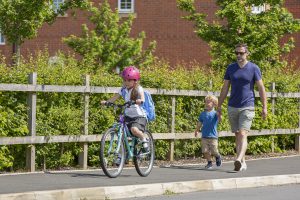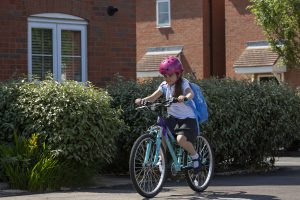Come rain or shine, the great British summer is all about sizzling barbecues, fun-filled beach trips and making memories with family and friends. While there may only be a few weeks left of the school summer holidays, there’s still plenty of opportunity for parents to make the most of the remaining time with their little ones before sending them off to school in September.
While the prospect of your child starting school may seem rather daunting, teaching them how to ride a bike during the final weeks of summer can build their confidence and help them become better prepared for a new routine. Additionally, allowing them to ride a bike or scooter to school can make the school run a less stressful experience!
In this article we’ll cover the benefits of cycling to school, bike teaching and safety tips, and how to choose the right bike to ensure your upcoming school run is as stress-free as possible.
The benefits of biking/scooting to school
The thought of the school run can be a worry for parents, particularly if they’re unsure how their child will adapt to a new situation.
Letting your child bike or scoot to school can bring a range of benefits from helping boost their confidence to providing some independence.
Riding is fun
Hopping on a new bike or scooter is an exciting experience for children and can be a fun activity to help lift their spirits. The joy of whizzing along can soon transform the school run into a positive journey that the child can look forward to each morning.
Riding improves physical and mental wellbeing
The NHS recommends school children engage in at least one hour of physical activity each day throughout the week to maintain a healthy lifestyle. Biking and scooting to school are fantastic ways to contribute towards your child’s daily physical activity.
Additionally, cycling has been proven to boost mental wellbeing and could help ease any potential anxieties your child may have around starting school.
Riding encourages independence
Entering school can be a challenging time for little ones as they’ll be meeting different people and discovering new processes. Learning to ride a bike during the summer can be a brilliant way to help them build their independence and confidence, making it easier for them to adapt to new situations.
Bikes and scooters can easily be carried home
Riding to school is excellent for children, but what about when parents have to carry the bike or scooter home? Thankfully, there are a range of foldable bikes and scooters on the market, making it easier for parents to pick up and carry away.
Some of our favourite foldable bikes and scooters include the Trunki Folding Balance Bike and the Trunki 4-in-1 Folding Kids’ Scooter. Foldable bikes and scooters are designed to be lightweight and folded flat – perfect for families on the go!
Cycling and scooting are better for the environment
Transport remains a significant contributor to total UK carbon emissions. Cycling or scooting to school can help reduce your carbon footprint, ease congestion around the school gates and get your child engaging in sustainable practices from an early age.

Choosing the right bike for your child
Before your child sets off on their cycling adventures, it’s essential to choose a bike that best suits their requirements. Finding the correct size bike for your child is key because a bike that’s too big, that they will ‘grow into’, can make learning much more difficult. For further guidance, take a look at our kids’ bike size chart, which also contains useful information about how to measure your child for their first bike.
Secondly, you’ll want to consider whether your child would benefit more from learning with a balance bike or a bike with stabilisers. This question is highly debated amongst parents when buying a first bike for their child, with each option having their own set of advantages.
Bikes with stabilisers have been a trusted method for teaching children how to cycle for many years and, chances are, this will have been how you learned. We all remember the first time our bike stabilisers were removed and how we desperately struggled to keep balance!
However, balance bikes have surged in popularity in the UK over recent years and have become a preferred bike teaching method for parents. So, which bike is best for your child?
The advantages of bikes with stabilisers
Stabilisers are excellent for providing kids with a boost of confidence when they first hop on their bike. Your child will soon become familiar with pedalling and braking without the fear that they will topple over at any given moment!
The potential disadvantage to bikes with stabilisers is that your child could become reliant on them and struggle to balance once they’ve been removed.
The advantages of balance bikes
Balance bikes don’t have pedals, so children are required to use their feet to move along and stop, helping to build muscle strength and coordination. With balance often being the most difficult skill to master when learning to cycle, balance bikes can make the transition to mastering a bigger bike much easier.
There is the potential that your child could soon outgrow their balance bike if they perfect the art of balance quickly. However, with many affordable balance bikes on the market, this is sure to be a worthwhile investment.
Is a balance bike better than a scooter?
A scooter is also a fantastic option for helping your child develop their sense of balance and steering, while allowing them to participate in a healthy outdoor activity. Both balance bikes and scooters can create a bit of school run fun and give your child the confidence to merrily whizz along!

Tips for teaching your child how to ride a bike
Learning to ride a bike is a significant childhood achievement, marking the beginnings of their independence. Although riding a bike is an exciting moment for children, it’s understandable that they may at times become frustrated with potential tantrums taking place along the way!
So, here are our top tips for parents looking to teach their child to master the art of cycling this summer:
Be positive
Whether your child chooses to ride a balance bike or use stabilisers, they are likely to be moments of frustration if they haven’t mastered a technique as quickly as they hoped. In these instances, it’s important for parents to remain positive and encourage their child as much as possible.
Stay focused
Minor accidents are to be expected when learning to ride a bike and, as a parent, it can be tempting to make a fuss or end the practice early. During these difficult learning periods, it’s important your child understands that it’s okay to make mistakes and recognise the importance of perseverance. So, when things don’t go according to plan, stay calm and do what you can to get them back on track.
Practice in an open space
When learning to ride a bike, it’s important for children to practice in an open space, allowing them to freely roam and get used to their new bike. If you think your child is likely to fall, it can be useful to stick to grassy areas that can help lessen the impact and prevent injuries.
Safety tips for cycling and scooting to school
Safety is the number one priority for parents, especially if their child is riding their bike or scooter on a busy school route.
Here are our top safety tips for children riding their bike or scooter to school:
Wear a helmet
It’s recommended that all cyclists wear a bike helmet, but it’s particularly important for learning little ones. It’s essential to pick the right size kids’ helmet that fits your child’s head correctly and doesn’t move around. Check the helmet has a snug fit around their head to ensure your child is fully protected while cycling.
Wear bright clothing
Wearing bright clothing when riding a bike to school will allow your child to be more easily seen by others. While it may not be the coolest attire, a hi-vis vest is beneficial to allow maximum visibility.
Cycling gloves and elbow/ knee pads are advisable
Cycling gloves and knee pads are excellent for providing extra protection for your child in the event of a tumble and can help keep their hands warm when cycling during the winter months.
Teaching your child how to ride a bike this summer can be a rewarding experience, helping you prepare for some school run fun!
If you’re looking to begin your child’s cycling journey this summer, Halfords is always here to help!


